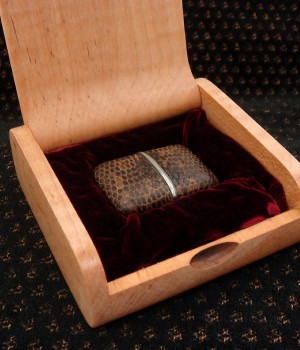
Item: W2503
Watch's origin: Swiss
Number of jewels: 15
Case: Grisite
Manufacturer: Movado
Type of Watch: Pocket
Type: Hunter
Dimension: 48mm by 34mm
Composition: Stainless
Other Attributes:
With Box
Price: $895.00
The Movado Ermeto, a pocket/purse watch manufactured between 1926 and 1985 in La Chaux-de-Fonds, Switzerland, was a joint creation between case maker Huguenin Frères and Movado.
Its case design was first patented in Germany in 1926 by Huguenin Frères, followed by patents in England, Switzerland, and the USA. Originally conceived as a pendant watch, it was modified by Movado and launched in 1926.
 The name "Ermeto" comes from the Greek "ermētikós," meaning "hermetic, sealed," reflecting the case's design, which protects the watch from dust, moisture, and shocks — though not hermetically sealed in the strictest sense. The rectangular case features two sliding covers that enclose the timepiece.
The name "Ermeto" comes from the Greek "ermētikós," meaning "hermetic, sealed," reflecting the case's design, which protects the watch from dust, moisture, and shocks — though not hermetically sealed in the strictest sense. The rectangular case features two sliding covers that enclose the timepiece.
The Ermeto range included four sizes: "Baby" (43 x 26 mm), "Normal" (48 x 34 mm), "Master" (54 x 37 mm), and "Pullman" (100 x 70 mm). The "Baby" was primarily for ladies' handbags, while the "Normal" was a unisex model. Movado, being a manufacture d'horlogerie, fitted the Ermeto range with in-house movements, though Lemania and A. Schild movements were used in some models, particularly those with complications like alarms or calendars. The concept and design, seen as upscale and somewhat futuristic, became immediately popular among the "Smart Set."
Movado advertised it as "Le troisième âge de la montre" (The third age of the watch), following the pocket watch and wristwatch eras. The Ermeto's success led luxury brands like Cartier, Hermès, and Tiffany to sell models under their names. In fact, the piece was so successful, Hugenin Frères and Movado had to issue warnings against imitations. Many companies attempted to replicate the Ermeto, and none matched its success or the patented rack-winding system.
In 1927, Isidore Ditesheim invented a unique mechanism for the watch known as 'Non-Stop,' which wound the movement when the case was opened and closed, eliminating the need for manual winding. This innovation contributed to the Ermeto winning the grand prize at the 1929 Barcelona International Exposition. By 1930, Huguenin Frères had introduced another patent for an automatic strut that deployed when the case was opened.
 This work of tactile art and horological history was available in various metal cases (platinum, gold, silver, vermeil, steel) with finishes like lacquer, niello, enamel, and guilloché enamel. Although the case shape remained consistent, the style of dials and hands evolved, helping to date specific pieces. It could be used with or without a chain and often featured a folding strut to serve as a travel clock.
This work of tactile art and horological history was available in various metal cases (platinum, gold, silver, vermeil, steel) with finishes like lacquer, niello, enamel, and guilloché enamel. Although the case shape remained consistent, the style of dials and hands evolved, helping to date specific pieces. It could be used with or without a chain and often featured a folding strut to serve as a travel clock.
Notable owners included Pope Pius XI, King Albert I of Belgium, King Edward VIII, Clara Bow, Andy Warhol (who owned at least six), and His Majesty King Charles III, whose Ermeto was stolen and later returned in 1994. It’s also said that an early model was presented to Albert Einstein.
We are intensely pleased to offer a beautiful example of the classic Ermeto by Movado in exotic skin over stainless steel, circa late '30s/early '40s. Measuring approximately 48mm by 34mm, it is the "Classic" or "Normal" size, typically carried in the purse, trouser or tuxedo pocket. The piece originated from an estate and made its way to us, where it was carefully cleaned, oiled and calibrated. We've restored the dial but left the case completely original, as it is in remarkably good condition. It comes in its own custom-made; custom-fitted, velvet-lined maple presentation box.
Please enjoy images of this discreet, handsome treasure!
PLEASE NOTE: We love our overseas clients, however, we cannot ship this watch out of the U.S. because of the exotic skin.